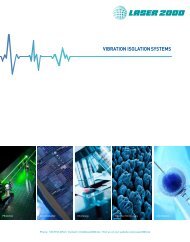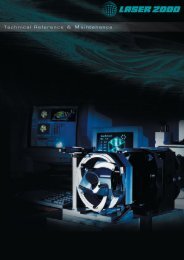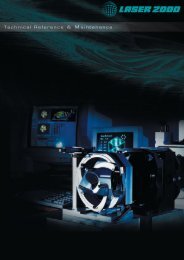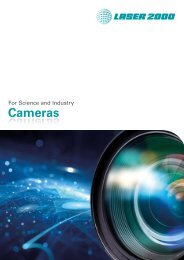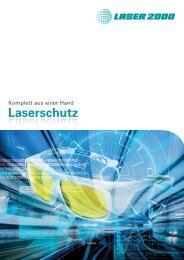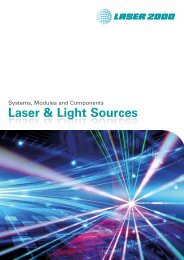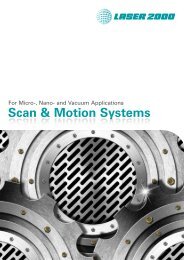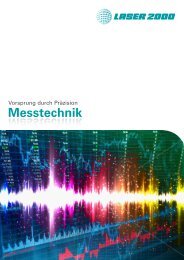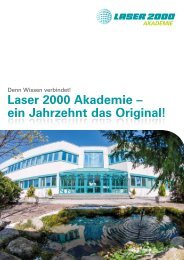Semrock Master Catalog 2018
Semrock Master Catalog 2018
Semrock Master Catalog 2018
Create successful ePaper yourself
Turn your PDF publications into a flip-book with our unique Google optimized e-Paper software.
BrightLine ® Dichroic Beamsplitters<br />
TECHNICAL NOTE<br />
Flatness of Dichroic Beamsplitters Affects Focus and Image Quality<br />
Optical filters are generally comprised of multi-layered thin-film coatings on plane, parallel glass<br />
substrates. All <strong>Semrock</strong> filters use a single substrate with coatings on one or both sides to maximize<br />
transmission and reliability and minimize artifacts associated with multiple interfaces. The glass<br />
substrate is not always perfectly flat, especially after it is coated, sometimes resulting in a slight<br />
bending of the substrate. Fortunately, this bending has no noticeable effect on light transmitted<br />
through an optical filter at or near normal incidence. For light incident at high angles of incidence, as<br />
is the case for a 45º dichroic beamsplitter, the only effect of a bent substrate on transmitted light is a<br />
slight divergence of the beam axis.<br />
However, a bent filter substrate can have noticeable impact on reflected light. Examples include an<br />
excitation beam reflected off a dichroic before impinging on a sample object, or an imaging beam<br />
that is split into two colors using a dichroic. Two main effects may occur: the position of the focal<br />
plane shifts and the size of the focused spot or the quality of the image is compromised.<br />
Often a small shift of the focal plane is not a problem, because a lens or camera adjustment<br />
can be made to compensate. But in some cases the focal shift may be too large to<br />
compensate – focusing a laser beam onto the back focal plane of the objective in a<br />
Total Internal Reflection Fluorescence (TIRF) microscope, or imaging the grid onto the<br />
sample plane in a structured illumination microscope represent cases where care should<br />
be taken to use a flat dichroic, such as those designed for laser applications (for example,<br />
see page 69).<br />
larger<br />
spot<br />
focus<br />
shift<br />
CCD<br />
lens<br />
sample<br />
CCD<br />
lens<br />
bent<br />
dichroic<br />
objective<br />
A bent dichroic can introduce aberrations.<br />
D = 7.5 mm; fTL = 200 mm<br />
Fluorophores<br />
Single-band<br />
Sets<br />
Multiband<br />
Sets<br />
Cubes<br />
When light incident at 45º is reflected off a dichroic with a slight bend, the resulting<br />
optical aberrations (such as astigmatism) can degrade the quality of an image after an<br />
imaging lens. As an example, the graph on the right shows the spot size at an image<br />
plane that results from a perfect point source after reflecting off a dichroic with various<br />
radii of curvature.<br />
This plot is based on a typical epifluorescence microscope configuration, assuming a perfect point source at the sample location, imaged<br />
onto the image plane (e.g., CCD surface) by an ideal 40X, 0.75 NA objective and a tube lens with a 200 mm typical focal length (industry<br />
standard tube length focal lengths range between 160 and 200 mm). The resulting beam diameter is 6.75 mm. The reflection off the<br />
dichroic is assumed to occur mid way between the objective and the tube lens. The field of view of the system is assumed to be limited<br />
by a 20 mm diameter field size at the camera plane. The light is assumed to have a wavelength of 510 nm (peak of GFP emission). For<br />
comparison, the diffraction-limited spot size that would result from a perfect objective and tube lens and a perfectly flat dichroic is 16.6<br />
μm (red line on plot).<br />
A sufficient criterion for an imaging beam (i.e., focused onto a detector array such as a CCD) reflected off a dichroic is that the<br />
diffraction-limited spot size should not change appreciably due to reflection off the beamsplitter. The required minimum radius of<br />
curvature for a number of objective-tube lens combinations (with standard tube lenses) that are common in fluorescence microscopes are<br />
summarized in the following figure. The required minimum radii vary from a few tens of meters for the higher magnification objectives<br />
(with smaller beam diameter) to as high as about 50 to 100 meters for the lower magnification objectives (with larger beam diameter).<br />
While reflected image quality can be worse than the ideal<br />
diffraction-limited response for dichroics that are not perfectly flat,<br />
it should be noted that the true spot size at the image plane can<br />
be appreciably larger than the diffraction-limited spot size in an<br />
actual system. Nevertheless, care should be taken to select properly<br />
optimized, flatter dichroic beamsplitters when working with reflected<br />
light. Dichroics designed to reflect laser light (“laser dichroics,” see<br />
pages 72 and 73) are generally flat enough to ensure negligible<br />
focal shift for laser beams up to several mm in diameter. Dichroics<br />
designed to reflect imaging beams (“imaging dichroics”, see page<br />
64) have the most extreme flatness requirements, since they must<br />
effectively eliminate the effects of astigmatism for beams as large as<br />
1 cm or more.<br />
Printed from Poster Session # B675, ASCB Annual Meeting, 2009<br />
Raduis of curvature required (m)<br />
120<br />
100<br />
80<br />
60<br />
40<br />
20<br />
Dichroic Radius of Curvature (m)<br />
Dichroic radius of curvature affects spot size.<br />
0<br />
10x0.25 10x0.25 40x0.75 40x0.9 40x1.2 60x0.9 63.x1.4 100x0.75 100x1.4<br />
160 200 200 200 160 200 160 200 160<br />
Magnification x NA Tube and Lens Focal Length (mm)<br />
Desired radii of curvature of dichroics suitable for image splitting applications for<br />
a number of common microscope objectives. Each objective is labeled with its<br />
magnification, numerical aperture (NA), and associated tube lens focal length (in mm).<br />
Laser<br />
Sets<br />
NLO<br />
Filters<br />
Individual<br />
Filters<br />
Dichroic<br />
Beamsplitters<br />
Tunable<br />
Filters<br />
67<br />
More



